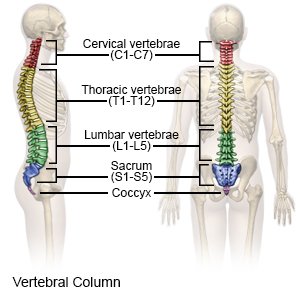Corpectomy
Medically reviewed by Drugs.com. Last updated on Aug 4, 2025.
WHAT YOU NEED TO KNOW:
Corpectomy is surgery to remove one or more vertebrae (bones) in the spine. This is usually done to take pressure off the spinal cord and nerves.
 |
HOW TO PREPARE:
The week before your surgery:
- Arrange to have someone drive you home after surgery. The person should stay with you for 24 hours to watch for signs of a reaction to the anesthesia. You may also need to have someone help you with daily activities for a few weeks while you heal.
- Tell your surgeon about any allergies you have. Tell him or her if you have ever had an allergic reaction to anesthesia.
- Tell your surgeon about all medicines you are currently taking. Include prescription and over-the-counter medicines, vitamins, and supplements. Your surgeon will tell you if you need to stop taking any medicines before surgery, and when to stop.
- You may need blood or urine tests before your surgery. You may also need x-rays, a CT scan, or an MRI of your spine.
The night before your surgery:
You may be told not to eat or drink anything after midnight on the day of surgery.
The day of your surgery:
- Take only the medicines your surgeon told you to take.
- You or a close family member will be asked to sign a legal document called a consent form. It gives healthcare providers permission to do the procedure or surgery. It also explains the problems that may happen, and your choices. Make sure all your questions are answered before you sign this form.
- Healthcare providers may put an IV into your vein. You may be given liquids and medicine through the IV.
- You will be given general anesthesia to keep you asleep and free from pain during surgery.
WHAT WILL HAPPEN:
What will happen:
- A large incision will be made near your vertebrae if you are having open surgery. Several smaller incisions will be made if you are having laparoscopic surgery. Your surgeon will remove tissue and bone with a drill or other tool. One or more pieces of bone may be taken from another area of your body, such as the hip. These pieces are used to fill in the space where bone was removed and are called bone grafts. Other materials, such as titanium or carbon fiber, can also be used as a graft. A metal plate may be placed over the graft and screwed into the surrounding bone to help support the spine.
- An x-ray may be done to check the placement of any grafts, plates, or screws used during surgery. A drain may be placed in your wound to remove fluid from the surgery area. The incisions will be closed with stitches and covered with bandages.
After your surgery:
You will be taken to a room to rest until you are fully awake. Healthcare providers will monitor you closely for any problems. Do not get out of bed until your healthcare provider says it is okay. When your healthcare provider sees that you are okay, you will be taken to your hospital room.
CONTACT YOUR HEALTHCARE PROVIDER IF:
- You have a fever.
- You get a cold or the flu.
- You have questions or concerns about your surgery.
Risks
You may bleed more than usual or get an infection. Nerves in the area where the vertebrae are removed may be injured. Nerve damage can cause hoarseness or problems swallowing or controlling your bowel or bladder. You could lose the ability to move your arm or leg (paralysis) if your nerves are damaged. You may need to have more surgery. If you have a bone graft from your hip area, your hip could break or you could have problems walking.
Care Agreement
You have the right to help plan your care. Learn about your health condition and how it may be treated. Discuss treatment options with your healthcare providers to decide what care you want to receive. You always have the right to refuse treatment.© Copyright Merative 2025 Information is for End User's use only and may not be sold, redistributed or otherwise used for commercial purposes.
The above information is an educational aid only. It is not intended as medical advice for individual conditions or treatments. Talk to your doctor, nurse or pharmacist before following any medical regimen to see if it is safe and effective for you.
Further information
Always consult your healthcare provider to ensure the information displayed on this page applies to your personal circumstances.
